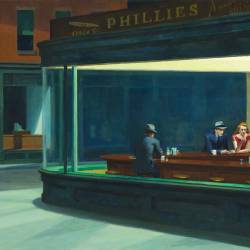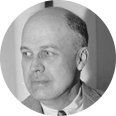Edward Hopper canvas prints & artprints
A leading figure in American realism, Edward Hopper is undoubtedly one of the most recognised artists in the United States. From Europe, where he completed his training, to New York, where he painted the majority of his canvases, he was able to evolve his style and depict the American culture of the early 20th century through paintings that depict the American Way of Life from the 1920s to the 1950s without artifice. Discover the most famous works by this famous American painter available in the catalogue, from his emblematic work "Nighthawks", in which we become spectators of the solitude of the characters emanating from the night, to his other canvases such as "Morning Sun" and its refined composition playing on the shadows of the sun, "Cinema in New York", a dark portrait in opposition to the American entertainment present in the background, or "Gas", a painting representing the dichotomy between nature and industrial expansion.
Treat yourself to an Edward Hopper art print, and discover the biography of one of the greatest masters of realism.
Edward Hopper biography: Everything you need to know about this major artist of realism
Edward Hopper's training: A first step towards realism
Far from the art world, Edward Hopper was born in 1882 into a family of New York shopkeepers. It was when he wanted to become an advertising illustrator that he discovered painting, and was naturally directed towards the artistic movement of realism, thanks to the lessons of Robert Henri, a major figure in American impressionism at the time, and one of his teachers at the New York School of Art. It was under Henri's influence that the Ash Can School, a movement based around American realists, came into being. From 1906 onwards, Hopper travelled to Europe, and more specifically to France and Paris, where he stayed on several occasions. It was at this point in his life that the painter became interested in the artists of the European realist movement, particularly Dutch painters such as Rembrandt, and the impressionist movement, notably Edgar Degas, of whom he became a fervent admirer. He produced his first paintings, which went against the grain of the Parisian effervescence around the artistic movements of Cubism and Surrealism, depicting views of Paris, its Seine, its bridges and its buildings such as the Louvre.
From European Impressionism to the "Edward Hopper style"
After this interlude in Europe and Paris, Edward Hopper moved to New York in 1908, where, as he had planned, he began working as an advertising illustrator, creating illustrations for advertising posters for a time. Not finding fulfilment in his work, he decided to devote himself to painting, and moved into a studio in the heart of New York in 1913. The American artist gradually abandoned his European artistic influences from the Impressionist painters, and, after a spell as an engraver, he specialised in his own style of painting, but still within the artistic trend of realism, with oil painting on canvas, based on large areas of colour, structured geometry and compositions playing on contrasts and light with marked shadows. In more earthy colours, far from the luminosity emanating from Impressionist paintings, he nevertheless continued to paint scenes of raw, unvarnished life, far from the American idealism represented by many of the great American painters and artists of his time. The play of shadows is marked in the artist's work, and his paintings, imbued with mystery and uncertainty, have inspired many contemporary and more recent film-makers, photographers and artists, from Alfred Hitchcock to David Lynch, Laetitia Molenaar and Tim Burton.
Edward Hopper's passion for American architecture
Although he produced a number of canvases featuring people, in the early part of his career, and particularly in the 1920s, Edward Hopper mainly painted houses and other buildings, in which architecture was the central subject. Among his many works, we find "House by the Railroad" (1925), "Early on a Sunday Morning" (1930), and the various paintings of his Cape Cod home, which highlight the lines and angles of buildings, always with a frame and a play of light and shadow that reduce the boundary between painting and pho-tography. Hopper did not paint huge modern buildings, but wanted his paintings to convey classic American life, far removed from the bustle of bustling and sometimes meaningless urban centres. That's why his work features a large proportion of places that are often isolated, like scenes of still life waiting to happen. Even in his depictions of cities, only the most innocuous buildings are represented, which, like the artist's work, cannot embellish reality and are often more representative of real life.
The works of Edward Hopper: a fresco of American melancholy and solitude in the 20th century
Although his career had been entirely focused on painting since the 1920s, Edward Hopper painted his most striking works from the 1930s onwards, which are considered to be the finest paintings in his collection. These include "Hotel Room" (1931), "Cinema in New York" (1939), "Morning Sun" (1952) and his famous painting "Nighthawks" (1942). It was at this point that a whole collection of characters took their place in his work. Through their portrayal, he depicted the inner workings of American society as close to reality as possible. As a result, we find a number of characteristics common to all these portraits and slices of life, such as the solitude of big cities, melancholy and expectation. It's about being, not appearing, and highlights the sense of unease in a society that always wants to show itself in its best light. Each scene, night or day, in the city, by the sea or in the countryside, in a bedroom, a bar, a club or a cinema, and depicting both men and women, is a window onto the intimacy of the characters.
Edward Hopper: From publicist to painter, a reputation gradually earned
At the time, it was common for painters and artists to go unrecognised by their contemporaries, but this was not the case for Edward Hopper. Recognised in his own lifetime as soon as his painting "House by the Railway" was completed in 1925, the art world quickly accepted the New Yorker as one of its own. In 1930, the Museum of Modern Art (MoMA) in New York put the spotlight on him and his collection by buying this painting, followed by the Whitney Museum of American Art, which bought "Early on a Sunday Morning". Given the growing number of works produced by the artist, the same Museum of Modern Art (MoMA) devoted its first retrospective exhibition to him in 1933. From then on, he was regarded by the cultural world as a major American painter, and in 1953 he was even awarded the title of "Doctor of Fine Arts" by the Art Institute of Chicago. When he died in 1967 at the age of 84, in the same studio where he had set up in 1913, his wife, also an artist, bequeathed many of her husband's famous works to the Whitney Museum of American Art. In addition to this museum, many of Edward Hopper's famous paintings are now on show at MoMA, the Museum of Contemporary Art in New York, as well as in the museums of the Art Institute of Chicago and the Museum of Fine Arts in Boston, which means that Edward Hopper is still considered a great painter in the history of American art, with a special place in the various artistic currents of realism.











































